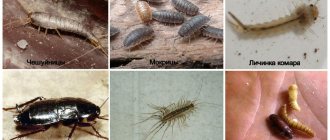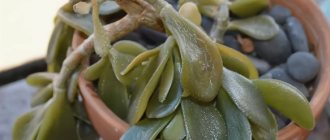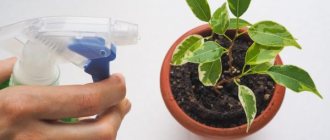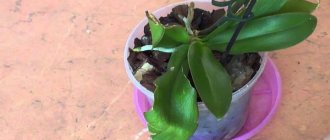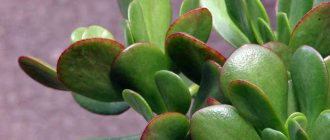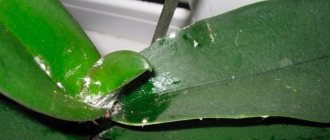Why is there a white coating and sticky spots on my Money Tree?
White spots and plaque on Money Tree (Crassula Ovata) are a common problem and can ruin the appearance of the most beautiful plant.
Luckily, identifying the causes and treating this problem is easier than you think. The main reasons for the appearance of a white coating on the leaves of Crassula can be mold such as powdery mildew, excess salt secretion or insect infestation. Our guide will help restore your flower to health and optimal appearance. Read more about this below.
Spots on tomatoes - diagnosis
For your convenience, we have compiled a table for diagnosing problems with tomatoes by leaf color. You can immediately go to this table with photos of the most common spots on tomato leaves to make it more convenient for you to determine the cause of the problem and determine countermeasures. For a more detailed description of possible tomato diseases or other problems associated with disruption of the supply of nutrients to the tomato bush, read on.
Reasons for the appearance of white-silver dots on Crassula leaves
There are only three main reasons for the appearance of a white or silvery coating on the leaves of a plant: powdery mildew or ashtray, excess salts in the water, and insect infestation. Very rarely, the plant may secrete epicuticular wax (a natural barrier against sunlight). But this happens extremely rarely.
What to do with powdery mildew
Powdery mildew is a common cause of white spots. This white mold is a fungal disease that usually affects indoor plants. When this fungus infects a plant, it forms small white round spots on wide parts of the flower.
In Crassula, these spots appear on the leaves. In later stages, powdery mildew can be identified by fuzzy fungal threads that spread along the stems. The growth of powdery mildew is favored by low light and temperature, poor air circulation, and high humidity.
If powdery mildew can be identified at an early stage, treatment is quite easy. Simply spray the leaves with a solution of one tablespoon of baking soda, one teaspoon of homemade soap and 3-4 liters of water. Use it daily until the white spots disappear.
Excess salts: what is it and how to get rid of it
The money tree is a succulent that stores most of its water in its fleshy leaves. If you water your plant with water that has a high salt content, it can cause those unfortunate white spots or plaque to appear.
Crassula tries to restore the balance of salt content in the leaves, so it removes them through the pores. Unfortunately, such a coating is very similar to the initial stage of the appearance of powdery mildew. Watering from above can also cause stains on the leaves of the flower: the water evaporates and simply leaves salts on the leaves.
The easiest way to determine what you are dealing with is to wipe the leaves with a damp cloth and wait a week . If the spots reappear and look like fuzzy fungus, it is most likely powdery mildew. Salts cannot be released so quickly.
How to fight and how to treat Crassula infestation with insects
Insect infestation causes Money Tree chlorosis. Chlorosis occurs when a plant does not produce chlorophyll correctly and leaves begin to lose color and fall off. Mealybugs and spider mites can cause this (it is important to consider the differences in methods of controlling these pests).
What to do if mealybugs appear that look like cotton wool
Mealybugs are one of the most common insects that attack Crassula. You can identify them by their appearance (small flat white bugs). Usually they try to hide in the folds of the plant.
A popular remedy against scale insects is a cotton pad treated with alcohol. Just wipe the areas where bugs and their eggs accumulate. A preventative measure involves spraying a mixture of alcohol and water directly onto the bush every day for one month.
How to treat spider mites on Crassula
Spider mites are small red spiders that burrow into the soil. You can identify them by the white spots on your leaves. In later stages, cobwebs are visible on the leaves and stem of the flower. If left untreated, this will eventually kill the plant.
To determine if spider mites are causing the problem, simply shake the plant over the paper and look for red dots on the paper. If you find them, start treating the plant with alcohol once every three days for a month. This will kill the ticks and their eggs.
Less common pests
Aphids and thrips can also cause white spots to appear on Crassula. You can fight them in the same ways - just spray the flower with a mixture of water and alcohol. Keep doing this until the problem goes away.
What is powdery mildew and how to fight it
Powdery mildew is a disease caused by various types of microscopic powdery mildew fungi. It affects many crops, but although the symptoms of the disease (as well as the principles of combating it) are the same everywhere, each of the pathogens “specializes” only in one or several types of plants. Therefore, there is no need to be afraid that oak powdery mildew will spread to phlox, gooseberries or cucumbers. The fungus infects mainly young parts of plants: petioles, leaves, shoots, green berries. First, small spots appear on the leaves in the form of a white coating. When magnified, it is clearly visible that these are threads of a fungus - mycelium, which looks like a thick cobweb. It grows quickly, the spores easily break off from the chains and scatter in the form of a white powder similar to flour. The process continues all summer, and the germinating spores are undemanding to moisture, and the disease spreads even in dry weather. The concentration of spores in the air and the risk of plant infection constantly increase from spring to mid-summer. However, in most plants by this time the leaves are covered with a protective waxy coating - cuticle, and it becomes more difficult for fungi to penetrate living tissue. At the end of the growing season, small black dots become noticeable on the affected tissue - these are new fruiting bodies that have formed. They are able to tolerate unfavorable conditions, overwinter well on plant debris and on affected parts of plants, and germinate next spring when warm weather sets in. In spring, spores fly out of the mycelium bags and infect new plants.
Prevention of powdery mildew
- Mixed planting of unstable crops (phlox, roses, delphiniums), refusal of monoculture.
- Timely removal of plant debris and fallen leaves.
- Deep tillage of the soil for annual flower and garden crops, as well as between rows.
- Balanced feeding.
- From the second half of summer - reduce the dose of nitrogen fertilizers. During an outbreak of powdery mildew activity (usually late June - early July), it is better to feed plants with phosphorus-potassium fertilizers.
- The use of complex fertilizers with microelements, the addition of wood ash. Foliar feeding with microelements.
- Regular watering - leaf resistance decreases during drought or due to insufficient watering (for example, caragana, common barberry, maple will get sick faster on sandy soil).
- Preventive autumn and early spring soil treatment in tree trunk circles with copper-containing preparations.
- Selection of resistant varieties.
Control measures
The development of powdery mildew can be suppressed by spraying plants with special preparations. Repeated spraying with fungicides is carried out after 10–14 days. For greater effectiveness, it is recommended to alternate medications. Pay special attention to trimmed hedges and at-risk plants.
Risk group
You've probably noticed that young oak growths and shoots of trimmed hedges from species sensitive to powdery mildew, new maple leaves are almost always covered with a white coating. Indeed, plants that produce young growth and new leaves throughout the summer, when powdery mildew is most active, are more susceptible to the disease. The cuticle on adult leaves prevents the fungus from entering them. Weakened, soft or young leaves (growing back after pruning, shearing or due to intensive growth caused by increased fertilizing with nitrogen fertilizers) are not so tough, they are less protected.
Severely affected by powdery mildew
Trees and shrubs:
• Barberry • Birch • Hawthorn • Elderberry • Elm • Common oak (pedunculate) and many other types of oak (except red oak - its leaves are hard and dense) • Caragana tree (yellow acacia) • Horse chestnut • Maples of various types, the most sensitive red-leaved forms of Norway maple (sycamore), Tatarian maple and ash-leaved maple • Hazel • Roses and rose hips • Rowan • Lilac • Currant and gooseberry • Apple tree • Ash
Herbaceous plants
• Cruciferous crops (except for those with fleshy leaves, such as cabbage) • Bluegrass • Cucumbers, pumpkins, tomatoes • Peonies • Phlox • Chrysanthemums • Sage
Preventing the problem with proper care
If you see white spots on your Money Tree and can determine the cause, your flower is one step closer to health! But to prevent the problem from recurring, it is important to properly care and maintain your Succulent.
Lighting
Crassula needs at least 4 hours of bright sunlight every day. If this is not ensured, the plant will begin to stretch and become susceptible to pests. Low light also stimulates the growth of powdery mildew. So place your flower on a south-facing windowsill.
Watering
Always make sure the soil surface is dry before watering again. Crassula plants require less moisture than traditional houseplants. In addition, reducing the amount of moisture in the soil interferes with the development and growth of fungi. Proper watering is one of the most difficult and important skills when caring for indoor plants.
Temperature
Make sure you provide enough bright light for your flower, avoid excessive humidity and make sure the room temperature is maintained between 18-24°C. This will avoid the appearance of white coating on the leaves and grow a healthy tree. Make sure that the conditions for keeping the Money Tree match those that suit the flower.
White spots
If the plant appears to be dusted with white powder, it is most likely powdery mildew. At first the spots are small, then they increase and cover an increasingly larger area.
Not only leaves are affected, but also stems and fruits of plants. The plate itself is superficial, covering both sides of the sheet, but there is more of it on top. Subsequently, it becomes denser and may darken a little. Affected leaves turn yellow and dry out.
Silvery dots on the leaves and other parts of the Crassula: what is it and why does it appear?
Crassula rarely gets sick, but sometimes gardeners are bothered by the white coating that appears on the leaves and trunk. Diseases in Crassula can appear due to improper care or insect pests.
- Incorrect watering. White spots on the money tree indicate improper watering. The plant does not like excessive moisture. The roots of the succulent may begin to rot, in which case it will be much more difficult to save it (why do the roots rot and what to do in this case?).
- Mealybug. If you notice a white coating on the axils of the leaves or on the roots that looks more like cotton wool, this indicates that a mealybug has settled on your Crassula. This parasite slows down the growth of the plant and bends the shoots. Because of it, the leaves begin to fall.
- Spider mite. The appearance of spider mites is indicated by white-yellow spots on the leaves. If you miss treatment at this stage, this will lead to the appearance of cobwebs and parasites on the plant.
- Fusarium rot. The disease in the money tree is difficult to notice when the trunk and leaves have not lost their elasticity. If you find a white coating, try rubbing it gently with your fingers. If you smell mold, it means the succulent is affected by Fusarium rot.
Green and yellow spots on tomatoes - tomato mosaic
In tomatoes affected by this disease, a characteristic mosaic pattern appears on the tops in the form of alternating green and yellow spots. In young leaves, the mosaic pattern is more clearly visible than in older leaves. The disease spreads very quickly to nearby tomato bushes. In the future, yellowish spots may appear on the fruits. This is tomato mosaic , a viral disease. The virus is transmitted by insect pests in the soil, but first of all, infection occurs with seeds. Therefore, to prevent mosaic, it is necessary to choose seeds of hybrids that are immune to this virus. If there is no data on the variety’s resistance to mosaic virus, then the planting material must be pickled in a 1% solution of potassium permanganate for 20 minutes.
Plants affected by mosaic are not treated , but are removed from the site and then destroyed.
Crassula treatment: how to get rid of the problem?
If the fat plant is covered with a silvery coating, it is important to take timely measures to save the plant, and what exactly needs to be done is described below.
If watering was incorrect
Crassula needs rare but abundant watering, as it retains moisture. In summer, the plant should be watered 1-2 times a week, in winter – once every two weeks. Water the Crassula with water at room temperature. Pay attention to the location of the plant in your home (office). The succulent loves indirect sunlight.
What to do if you have mealybugs?
A soap solution will help deal with mealybugs. If you find only a white coating in the form of fluff, then treat the plant with cotton swabs. Repeat this procedure several times. If there are parasites on the affected areas, you can fight them with the help of insecticides:
Ventilate the room: Crassula’s immunity will be strong.
If you have spider mites
Spider mites do not like high humidity. You need to give the plant a warm shower, treat it with a soap solution, a solution of garlic or tobacco, cover it with a cap and create a greenhouse. Biological products such as:
After a week, repeat the procedure. Inspect other plants (if present) for harmful residents to prevent them from appearing again.
For fusarium rot
Fungicides cope with fusarium rot: “Fundazol” and “Fungicide”. It is necessary to transplant the succulent into a new pot.
- It is necessary to remove all the old soil, as traces of the disease may remain on it, and inspect the roots.
- If some of them have begun to rot, then they should be removed with sterile scissors.
- Dip healthy roots into a solution of potassium permanganate for a while.
- To make the plant take root faster, soak it in a root formation stimulator.
Despite its unpretentiousness, the money tree is susceptible to diseases. If you notice the disease in time and start fighting it, Crassula can be saved. With proper and competent care, you can extend the life of your plant for a long time.
Raised white spots
This is leucorrhoea or white cruciferous rust. Affects cabbage, radishes, radishes, mustard, turnips. On the leaves, stems and inflorescences there are numerous white bumps 1-2 mm, similar to bubbles.
On the leaves they are mainly located below, and yellowish spots are visible on the upper part of the leaf blade. If these growths are damaged, they will release a white powdery substance. These are fungal spores.
When infested extensively, the plant appears covered in thick white paint. The affected areas fold and dry quickly.
Improper care
First of all, you should consider the negative factors that relate to errors in plant maintenance. It is they that in most cases lead to a deterioration in the appearance of the fat plant, falling or blackening of foliage, disproportionate growth, etc.
Yellowing and falling leaves
Very often, owners of fat cats face this problem. In this case, to eliminate the problem, it is important to adhere to the following watering rules:
- Moisten the soil only with warm water, previously filtered or settled. When watering with cold water, the difference in air and soil temperatures can adversely affect the condition of the plant.
- Avoid excessive waterlogging of the soil during the cold season. This situation leads to rotting of the roots, as well as the formation of fungus.
- Dying of leaves can be caused by drying out of the soil in summer. If its top layer becomes too hard, you should immediately water the flower.
- prolonged exposure to direct sun;
- lack of sufficient fresh air flow;
- lack of nutrients in the soil.
Stretching the stem
Disproportional development of the bush often occurs due to insufficient lighting. If watering standards are observed, but there is a lack of sunlight, the fat plant stretches the stems, trying to get to the sun. As a result, there is insufficient development of leaves and branches, despite their large growth.
If the money tree is sick for this reason, just put it closer to the window. However, it is important to avoid excessive exposure to sunlight to prevent burns.
In some cases, the stems become elongated due to the normal development of the crassula. To prevent them from falling on their side, you should transplant the flower into a wide pot. Its root system grows in a horizontal plane, so transplanting it into a deeper container will not give the expected results.
soft leaves
If the foliage of the money tree has lost its elasticity and softened, then this could be caused by excessive watering, lack of lighting or inappropriate room temperature. The process of restoring the flower should be started immediately, otherwise it will soon die completely.
The plant is removed from the pot along with a lump of earth, then the soil is removed. The root system is being inspected.
Note!
If rotting or moldy areas are found, they are cut off. Next, the roots are washed under a stream of water at room temperature, the sections are treated with charcoal or activated carbon tablets crushed to powder.
All that remains is to plant the fat plant in a pot using a new substrate. For the first watering, carbendazim is used. The plant is placed in a bright place, but without direct sunlight.
There is no point in saving Crassula if rotting of the roots occurs at the base, or they are soft and dark along their entire length.
Leaves turn black
If the leaves of the money tree become covered with black spots, this is an indication of sunburn. The unhealthy area appears strictly at the point where the light ray hits and does not spread further. The blackened leaf can be removed, and care must also be taken to prevent direct sunlight from hitting the flower in the future.
However, there is another reason for the formation of black spots on the leaves of the fat plant - fungal infection. The fight against this disease consists of using the drug Fitosporin-M. It is diluted in a twice as large volume of water, after which it is thoroughly stirred and diluted again with water (the procedure will be described in more detail in the instructions for the drug). The foliage is sprayed with the resulting solution, and after a while the operation is repeated.
Lack of growth, drying out
Crassula will stop growing if its roots become crowded in the pot. You should choose a container that is slightly larger in volume. The new pot should be wider and only slightly higher, since the roots prefer to grow horizontally. It is better to transplant a flower in the spring, but if it is infected with fungus or other diseases, the procedure cannot be postponed.
A slowdown in development can also occur during winter dormancy. This is a normal phenomenon and does not require any measures to be taken.
Another reason could be a lack of nutrients in the soil or poor lighting. It is necessary to purchase complex fertilizers in a specialized store and use them in accordance with the instructions.
Important!
Drying foliage indicates an incorrect watering regime. Excessive or insufficient amounts of moisture may be added to the root. In summer, watering is carried out more often, after the top layer of soil dries, in winter - less often.
White dots on leaves
The money tree can be overly saturated with moisture received not only from the ground, but also from the air. As a result, the plant has to open spores on the leaf blades to get rid of excess water.
The appearance of white spots does not promise any particular danger, however, you should pay attention to the frequency of watering and, if possible, reduce the humidity in the room (for example, increase the temperature with a heater if we are talking about the winter period).
Reddening of foliage
A change in leaf color from green to pale or even bright red can occur for three reasons:
Treatment will be appropriate:
- Provide the plant with shade.
- Ventilate the room regularly.
- Fertilize with nutrients. The need for this action is also indicated by wilting leaves.
Plant recovery after:
Improper care
If the appearance of pale leaf color was caused by errors during the cultivation of violets, and a specific source of trouble has been identified, then it is necessary to eliminate this irritant by adjusting care regimens and create favorable conditions for the plant to overcome the consequences.
Transplantation into new soil
Prolonged growth of a flower in old soil leads to alkalization or increased acidity, the soil:
- Cakes;
- Loses water permeability;
- And the ability for aeration disappears.
It is necessary to replant the violet into new soil once a year.
On the other hand, the growth of the root system and the small volume of the flowerpot lead to a lack of nutrients for the plant. All these are harbingers of the appearance of pale and yellow leaves in violet rosettes.
These troubles can be prevented by regularly replanting the flower . For young plants, replanting is used annually; older bushes change their flowerpots as they grow (about once every three years).
ADVICE! It is recommended to carry out the transplantation procedure in early spring using the transshipment method (to minimize damage to the roots).
Controlling the temperature of irrigation water
If it is determined that the cause of leaf lightening is water, the regime and methods of watering should be carefully reviewed .
Particular attention must be paid to the temperature of the irrigation water, since cold watering leads to freezing of the plant and a change in the color of the leaves to a lighter or mottled tone.
settled water at almost room temperature for irrigation
Temperature normalization
The optimal temperature for keeping violets is considered to be maintaining the thermometer at +20 +22°C.
Varieties of violets with variegated leaves respond especially negatively to increased temperatures . Maintaining prolonged heat leads to the disappearance of spots and patterns on the leaf blades, which acquire an even green tint.
Low temperatures can freeze the plant , which will immediately affect the color of the leaves - blanching or yellowing.
Draft protection
Regardless of the season, it is imperative to protect the violet from exposure to drafts, which, due to temperature changes, help lighten the color of the leaves.
The violet must be protected from drafts.
For the plant, you should find a bright place, not exposed to wind, and when ventilating, it is better to cover the flowers or put them aside.
Fungal diseases and infections
If you suspect that light spots on the leaves are caused by any disease, it is necessary to isolate the violet from other plants , try to classify the disease and apply known methods to combat it.
Among these diseases are the most common and dangerous:
- Powdery mildew - a white powdery coating is first visible, under which you can see light spots. Further, the spots darken, droplets of liquid appear on them. Black dots of sporangia become noticeable;
- Gray rot - light grayish spots appear first at the base of the leaf. Gradually they spread over the entire plate, darken and rot;
- Bacterial spots - the presence of a much lighter border along the edge of the leaf blade;
- Bronzing virus - discoloration of the entire leaf blade.
Basic treatment methods
If a disease is detected, the violet must be immediately isolated from other plants to prevent the spread of infection.
After this, you should carefully remove all damaged leaves and treat the violet:
- Fungicides;
- Or biological products.
Be sure to adjust those care regimens that could contribute to the onset of the disease.
Next, monitor the condition of the flower , periodically using drugs to improve the condition, enhance endurance and immunity (Epin, Potassium Humate, Kornevin).
Drugs
ATTENTION! When treating violets with chemicals, it is imperative to use personal protective equipment. Ideally, take the plant to a special room.
Fungicides are used to combat diseases :
- "Bayleton";
- "Barrier";
- "Topaz";
- "Barrier";
- "Fundazol".
Violets need to be treated with various drugs.
When using medications, you must follow the instructions in the instructions . Severe damage requires repeated treatments.
At the first signs of the disease or when a small leaf area is damaged, it is possible to use biological products (for example, Fitosporin-M).
Parasite infestations
is not difficult with certain knowledge and the use of a magnifying glass The plant will require urgent quarantine and treatment with insecticides.
Violets can be threatened by various pests, among which the most dangerous are :
- Ticks (spider and cyclamen);
- Whiteflies;
- Thrips;
- Aphid;
- Scale insects;
- Front sights;
- Mosquitoes;
- And coccids.
These species directly damage leaf blades , first causing a change in their color. By feeding on the juices of the plant, parasites disrupt its decorative properties, weaken the flower, and contribute to the emergence of dangerous diseases in the next stages.
Ways to fight
Sprays are used to combat parasites :
- Acaricides;
- And insecticides.
Achieving a sustainable result is possible with two or three treatments with a week break.
In case of mixed pest infestation or if it is not possible to determine the type of parasite, you can treat the soil with biological preparations:
- "Fitoverm";
- And Aktellik.
Violets with pests need to be treated with medications.
They successfully fight many types of parasites .
IMPORTANT! In some cases, it is recommended to change the contaminated soil by replanting the flower.
Prevention
All newly purchased violets must undergo a quarantine period in a separate room (about 3 weeks).
You should not allow violets to be close to each other - their leaves should not touch .
Wildflowers and vegetables should not be placed next to violets, as they serve as carriers of pests that are dangerous to Saintpaulias.
Strict hygiene:
- Visual inspection of violets;
- Trimming old and wilted leaves;
- Cleaning window sills with soapy water.
Diseases
All Crassula diseases are a consequence of fungal or bacterial infection. Favorable conditions for their spread are dampness and cold air. Let's take a closer look at money tree diseases and their treatment with photo examples depending on the type of lesion.
Fungal diseases
Most often, infection by fungal spores occurs during cold weather, when there is increased air humidity in a poorly heated room. Wet or gray rot appears as brown spots, gradually increasing in diameter and covering the entire leaf.
Varietal features
Some varieties of zucchini, zucchini, zucchini, zucchini and other plants have variegated leaves. The white areas on them are a special loose tissue (eranchem), with the help of which plants are protected from the heat.
Sometimes this is mistaken for powdery mildew. However, if in the disease the white spots represent plaque, the arenchyma is an integral part of the leaf blade. It may not appear immediately, but, for example, only from 4-5 of this sheet.
Pests
In addition to Crassula diseases, pests also have a negative impact, photos of which will be presented below. These include spider mites, scale insects, mealybugs and rootbugs. The method of combating each type of insect is different and therefore requires separate consideration.
Shchitovka
This pest is quite large in size, so it is clearly visible to the naked eye. Females remain motionless, they are attached to a stem or leaf, covering their body with some kind of shield. The scale insect has a light brown or brown color.
The first step in the fight against the pest is its manual removal from the surface of the fat plant. Next, treatment is carried out with a soap solution or a commercial preparation called Fitoverm. To consolidate the result, spraying is repeated after a few weeks.
Spider mite
Unlike scale insects, Crassula is practically invisible on the surface. The appearance of a tick is determined only by the corresponding sign - a silvery coating on the money tree, which is actually a very thin cobweb covering its habitat. The pest itself looks like a gray or red dot continuously moving around the plant.
Along with the cobweb, a change in the appearance of the leaf plate occurs. It becomes covered with brown spots, turns yellow and falls off over time. A simple method of eliminating the mite is to spray the crassula and then wrap the pot in a plastic bag. This will sharply raise the humidity level, and in such conditions the pest does not live long.
Soap solution or preparations Apollo, Actellik, Fitoverm are also effective in removing insects.
Mealybug
The insect quite often attacks Crassula. Its habitat is the axils of the leaves, in which the juice is sucked and plant tissue is eaten. As a result, the immunity of the fat plant weakens, accompanied by the fall of leaves. Externally, the pest’s activity manifests itself as a powdery discharge resembling cotton wool.
You can remove the insect with a stream of water. The affected areas are wiped with a cotton swab dipped in garlic infusion or alcohol solution. In advanced cases, the drugs mentioned above are used.
Root mealybug
Some manifestations of money tree diseases are caused by root worms, which are very difficult to detect. It will be possible to identify the cause of the deterioration of the flower only during the process of replanting - growths and movement of insects with a white body will be noticeable on the roots.
The pest is removed under running water at a temperature of 50 degrees. After this, the roots are treated twice in a Fufanon or Actellik solution with an interval of 7 days.
Tomato nutritional deficiency
You can read more about nutritional deficiencies in the article on our website “What tomatoes lack: nutritional deficiencies.” You can determine which microelements the plant lacks by the appearance of tomato leaves. Their color, and the general condition of the leaf . The deterioration of the condition of tomatoes is most often caused by a deficiency (less often, an excess) of micronutrients. What kind of feeding tomatoes need can be determined by the change in color and condition of the leaves of the tomato bush. Now we will consider diagnosing a deficiency or excess of nutrients only by the presence of spots on tomato leaves.
Light yellow-green spots on tomato leaves - nitrogen deficiency
Tomatoes burn at the edges, old leaves turn yellow and fall off. Plants stretch out, look stunted, leaves become smaller, acquire a light green color with a yellowish tint, and the stem becomes soft. The veins on the underside of the leaf are reddish-bluish in color.
What to do? Feed the tomatoes with nitrogen fertilizer, for example, urea (1 tablespoon per 10 liters of water). Spots on tomato leaves and what to do? See here
Yellow-brown spots - potassium deficiency
Young tomato leaves roll up inside a tube - they become curly, and old leaves turn yellow and dry out at the edges. First, the leaves darken, then yellow-brown spots appear along the edges, which gradually grow, forming a border.
What to do? Fertilizing with potassium nitrate (1 tablespoon of fertilizer per 10 liters of water) half a liter of solution per bush, spraying the leaves with a solution of potassium chloride (1 teaspoon per 1 liter of water).
Yellow with necrotic spots - Excess potassium
With an excess of potassium, the lower leaves of tomatoes turn yellow and dark necrotic spots appear on them). Excess potassium is dangerous for plant roots. High potassium content can cause burns to the root system. In addition, excess potassium leads to difficulty in the absorption of nutrients such as calcium, magnesium, zinc, boron, etc.
What to do? Stop fertilizing with potash fertilizers and ash. Spots on tomato leaves and what to do? See here
Leaves curl upward and turn yellow - magnesium deficiency
Tomato leaves curl upward and begin to turn yellow between the veins.
What to do? Foliar feeding (spraying on the leaves) with a solution of magnesium nitrate (1 teaspoon per 10 liters of water) or Epsom salt diluted in the same proportion helps well.
Pale green spots on young leaves - sulfur deficiency
Signs of sulfur deficiency are similar to nitrogen deficiency: pale green leaf color turning yellow, red-blue veins. But sulfur deficiency appears first on young leaves (with nitrogen the opposite is true). The stem of the plant also becomes thinner, it becomes brittle, brittle, and woody.
What to do? Foliar feeding with magnesium sulfate (1 gram per 1 liter of water) helps.
Purple spots - phosphorus deficiency
The leaves and stems of tomatoes darken to a dark green color with a blue tint, the lower part of old leaves acquires a purple tint. The leaves curl inward, the stem becomes stiff and brittle, and the roots wither. The tomato leaf color and stem may turn purple. At the same time, the leaves rise up and are pressed against the stem.
What to do? Feed the tomatoes with phosphorus-containing fertilizer. To prepare the fertilizer, pour 1 liter of boiling water into 1 cup of superphosphate and leave to steep for 8-12 hours. Dilute the resulting infusion in 10 liters of water and pour half a liter of fertilizer under each bush.
Tips for caring for Crassula
Caring for a fat woman is quite simple. It is enough to follow simple rules, and the money tree will grow for years without any plaque or other unpleasant phenomena.
Rules of a caring florist:
- To prevent silvery bloom, water the plant properly - in the summer about a couple of times every 1-2 weeks, and in the winter once every 10 days is enough.
- Inspect the tree regularly, and if you notice mealybugs or other pests, promptly wash them off with plain water or a soap and water solution. In case of large infestation, immediately use a solution of Fufanon, Actellik or similar medications.
- Provide regular feeding of the fat plant with vitamins and other means for active growth (biostimulants).
- Carry out preventive spraying against powdery mildew. Use fertilizers with phosphorus and potassium fertilizers (they increase the tree's resistance to infections and fungi).
- At the first signs of a silvery coating of powdery mildew, immediately wash the leaves with soapy water and treat the tree with Topaz or other similar protective agents.
- Make sure that the plant stands on the southeast side of the windowsill. Do not place it in a dark room or expose it to very strong sunlight.
- Maintain moderate humidity in the room.
